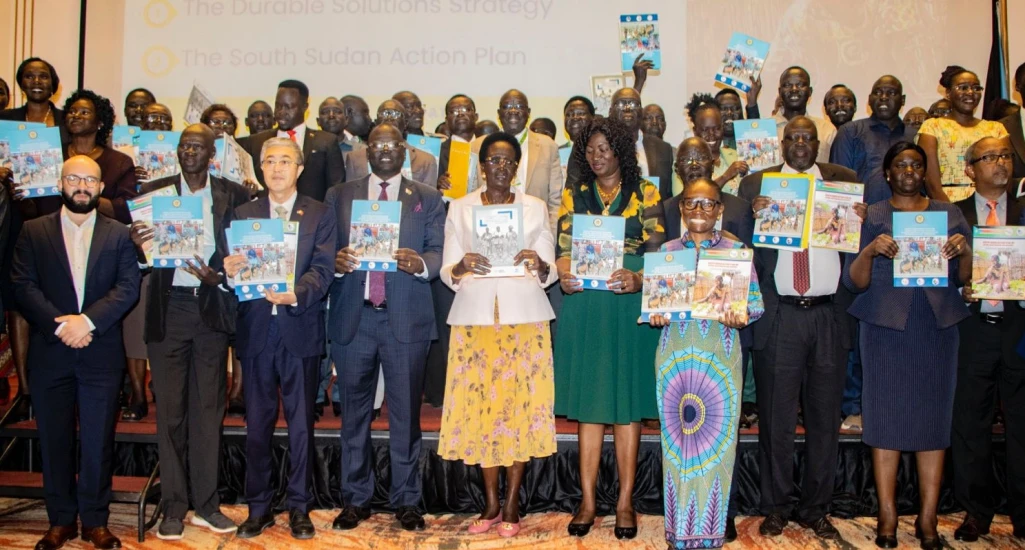
In a historic move, South Sudan has released two key documents that will help individuals affected by the country's conflicts and natural calamities.
These two documents include the South Sudan Durable Solutions Strategy and Plan of Action for Refugees, Internally Displaced People (IDPs), Returnees, and Host Communities.
This strategic document sets the tone for how the government line ministries, humanitarian and development actors will deliver solutions and provide overarching guidance.
It further introduces new solution architecture, which places the government in the lead and brings on board the other stakeholders.
The other document, the South Sudan Action Plan on Return, Reintegration, and Recovery for Achieving Durable Solutions 2024-2028, focuses on implementation modalities at the state level to implement a durable solution strategy.
The governments of Sudan and South Sudan, IGAD, EU, and UNHCR launched the Solutions Initiative in October 2020 as a flagship activity of the IGAD support platform to mobilize international support for early recovery and longer-term peacebuilding and resilience.
The National Council of Ministers endorsed the two documents in the same month.
Albino Akol Atak, minister of Humanitarian Affairs and Disaster management, stated that since 2019, the displacement situation in South Sudan has really worsened due to the natural disasters and conflicts both internally and externally.
“As of October 2024, South Sudan received more than 824,000 individuals from Sudan since the eruption of conflict in Sudan on 15 April 2023. In 2024, 9 million people need humanitarian assistance,” Akol said at the launch of the documents in Juba on Thursday.
“They include IDPs, returnees, refugees, and host communities. While our displacement is caused by numerous factors, including inter-communal fights and armed conflict, an even greater number of people are displaced by climate change.”
According to Akol, the current flooding has affected about 1 million people as of October 2024, primarily in the states of Jonglei, Unity, Upper Nile, Warrap, Northern Bhar el Ghazal, Central Equatoria, and Abyei Administrative Areas.
In 2019, on the sidelines of the first Global Refugees Forum, the governments of Sudan and South Sudan concluded that 7.2 million people had been impacted by displacement across both countries.
Akol stated that more than 75% are South Sudanese returnees and more than 23% are Sudanese refugees, among others.
He urged stakeholders to support the implementation of these action plans and strategies.
“I appeal for support to the implementation of the strategy to achieve solutions, particularly for returnees across the country, especially in high-return areas such as Malakal and Juba, refugees in Yambio and Maban, to mention but a few, and IDPs in protracted situations and host communities,” he mentioned.
“What is required is investment in solution activities which ensure basic needs are met. This includes livelihoods, infrastructure, development, health, education, and education to improve quality of life.”
The minister stressed that the distribution of relief is not enough to solve the humanitarian situation in the country.
“There is a need to engage in solutions. The data is clear. Strengthening the humanitarian peace development nexus remains imperative. Solutions cannot be achieved in the absence of peace and development. We need to invest in people,” he explained.
Furthermore, he emphasized that the integration of refugees, IDPs, returnees, and host communities, including their livelihoods, and the strengthening of government institutional capacities are crucial aspects that require collective responsibility.
Rebecca Nyandeng - vice president of the Republic of South Sudan and chair of the Gender, Youth, and Humanitarian Affairs Cluster - mentioned the significance of the documents.
“These documents are designed to guide authorities at the national, state, and local levels, humanitarian and development organizations, and other stakeholders in addressing the challenges encountered by displaced individuals as they endeavor to return to their areas of origin,” Nyandeng explained.
“The documents aim to uphold the rights of refugees and internally displaced persons to return safely and with dignity.
“They also stress the importance of creating a secure and safe environment for returnees, fair identification and documentation, and providing essential services and physical and legal protection.”